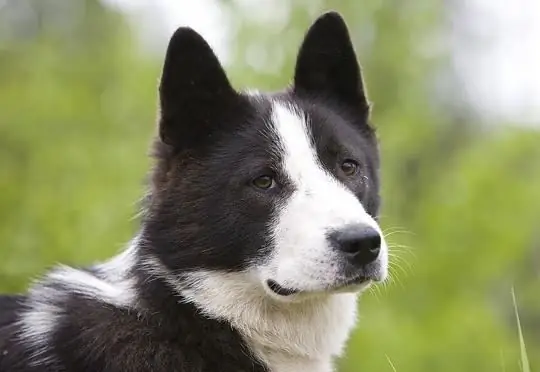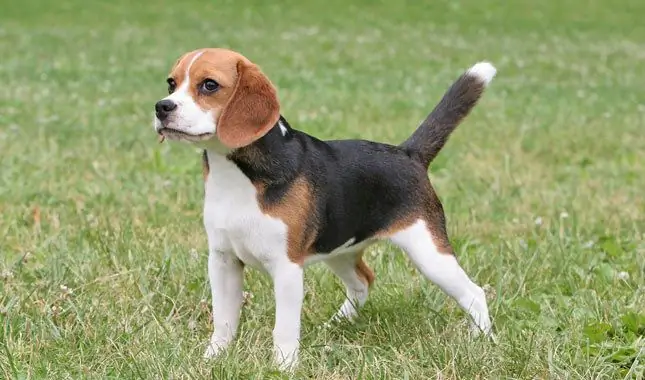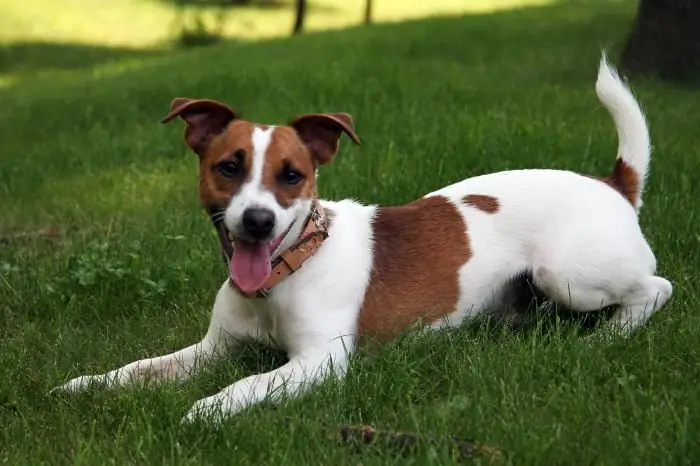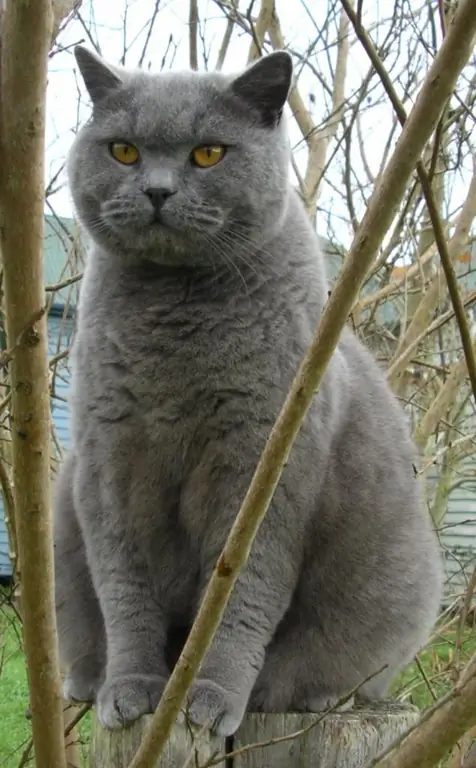2025 Author: Priscilla Miln | [email protected]. Last modified: 2025-01-22 17:55:19
Eskimo Laika is an interesting breed of dogs, whose homeland of origin is considered to be Eastern Siberia. Appearing in harsh climatic conditions, the animal embodied the best qualities of northern sled dogs.
Origin
Eskimo Laika is considered one of the ancient breeds of North America. The number of its representatives is steadily declining, and today the dog is rare. This species is also called the Canadian Eskimo Laika, as well as the Canadian Inuit. Inuit is the self-name of the Eskimo peoples. They called this breed kimmik, kimmit, which is translated from Inuit as "dog". It is believed that the first representatives of this species came to North America from Siberia a thousand years ago, along with the ancestors of Greenland dogs.

The animal in question is often confused with the American Eskimo (Laika) dog breed. There is little in common between them, and confusion occurs due to similar names. The canadian eskimo dog presented in the article is a large working dog, while the american eskimo dog (see photo below) is a medium-sized decorative animal.size, which has German roots, has nothing to do with the Eskimos.

Today
In our time, there are no more than 300 Eskimo huskies. If earlier these animals were used by the Inuit of the Canadian Arctic as sled dogs, now such dogs are a rarity in the North. The quadrupeds were supplanted by snowmobiles. Infectious animal diseases also contributed to the decrease in the number of huskies.
Description
Eskimo Husky has a large size, its appearance resembles a wolf. The sounds made by the animal are also similar to the howl of a wolf. The dog barks infrequently.
Breed standards:
- wide wedge-shaped head;
- small triangular ears;
- medium muzzle, getting narrower towards the nose;
- jaw strong, powerful;
- slanted deep-seated eyes;
- wide shoulder blades, well developed muscles;
- fluffy tail thrown over the back;
- wool length - up to 15 cm;
- hair color can be any, without restrictions;
- height - 51-69cm, weight - 27-47kg;
- Life expectancy is 13-15 years.

Character
Initially, the Eskimo Laika appeared and developed in a flock. Thanks to this, she developed an independent and wild disposition. Therefore, one should not expect uncharacteristic affection from an animal, although in general the dog’s attitude towards a person is quite positive, the dog rejoices at the owner’s praise. It may seem thatthe husky is not attached to its owner and behaves arrogantly, but this is not so. She also values relationships with a person, but does not show it as brightly as other breeds.
Eskimo Husky has excellent protective qualities. And if the owner put her as a watchman, then he definitely has nothing to worry about. The dog will not miss a stranger for anything.
After considering the description of the Eskimo Laika breed and character, you should dwell on the intricacies of animal care.

Content Features
Eskimo huskies are accustomed to cold snowy winters. The heat is unbearable for them. Therefore, in the summer, the owner must equip a shaded place for the animal. Cool drinking water is required.
Keeping like in an apartment is strongly discouraged. These animals need space and space in order to run. Otherwise, the four-legged friend runs the risk of becoming obese and acquiring a host of other diseases caused by a sedentary lifestyle. In addition, the dog does not bark, but howls. This feature can cause a lot of trouble for neighbors.
A good option for a husky would be a spacious enclosure where the dog can move as much as he wants.
Hunting behavior
Eskimo huskies (whose photos are in the article) have strong hunting instincts. They are born hunters. The pursuit of the beast brings them genuine joy.
If the pet is bored, it is worth taking him hunting, this activity will bring him real pleasure. It is very interesting to observe the behavior of the dog during this process. In the hunting season for furs (squirrel, sable, marten), the husky first searches the territory and signals the owner with a voice about the discovery of animals. If birds are being hunted, the dog distracts the game so that the owner can fire a shot. Similar behavior is also observed during the hunt for a wild boar.
If the owner went after a large animal, the behavior of the husky changes to aggressive. The dog attacks the animal, driving it into the sump.
Collar and leash training
Of course, wearing these attributes is mandatory. But to accustom a dog to a collar is worth gradually. No need to immediately put on hard. First you should pick up a wide leather. Puppies do not immediately get used to such an accessory, initially they try to rip it off. The owner during this period will need a lot of patience to distract the dog from removing the collar.

After the puppy is used to the collar, it's the turn for the leash. This stage is even more difficult, because the nature of the huskies is strong and strong-willed. When putting on the leash for the first time, encourage the animal with a treat. Also, do not immediately pull on the leash: let the dog get used to the accessory, get used to it. It is important for her to understand that the owner is next to her at this moment.
The time for which the dog gets used to the collar and leash is 4-6 months. After that, you can, without fear, let your husky off the leash for a walk or in the forest.
Then comes the training of commands with the puppy. The main thing that a four-legged friend should understand at this time isthat he has maximum freedom of action. Then success from training will not keep you waiting.
He alth
Eskimo type of huskies has excellent he alth. The only group of diseases that can affect dogs is the pathology of the musculoskeletal system. This is due to insufficient range of motion. To help the animal avoid such diseases, it is worth giving cottage cheese as food more often, as well as raw vegetables.
It is important to brush your pet regularly, especially during shedding.
Food
Daily, the dog should receive natural food: meat, fish, vegetables, dairy products, and vitamins.
S alty, smoked, spicy, spicy food, sweets should not be given.
Overeating can be detrimental to he alth.
Compliance with all the proposed recommendations will help the owner to raise a he althy animal that will become a true friend.
Recommended:
Maine Coon and child: relationship with children, description and character of the breed

Maine Coon is a beautiful and powerful cat breed that truly fascinates with its size. This wonderful creature gets along well with all family members and can become an irreplaceable friend for many years to come
East Siberian Laika: photo and description of the breed, character of the dog, features of care and maintenance, owner reviews

The East Siberian Laika, the description and photo of which will be presented in this article, has existed in its current form for about 2 centuries. Although the modern look was preceded by many modifications of the ancient types of dogs. Laiki are not a decorative breed, but their popularity has increased recently. Why are these dogs so cute for people? How to identify the breed among the rest? How to properly care for them, and how much do they cost?
Beagle: description of the breed, character, pros and cons, training, features of care and maintenance

Today, almost every family has a pet that gives its owners positive emotions. The Beagle breed is a hunting dog. As a rule, its representatives have an active and mischievous character. They are very mobile and incredibly smart, get along well with both adults and children. For more than a hundred years, this breed has occupied a leading position in the list of the most popular. How did the beagle conquer the hearts of dog breeders? Let's try to figure it out
Jack Russell Terrier: breed description, photo and character. Pros and Cons of the Jack Russell Terrier Breed

There is probably no more playful, active and interesting dog than the Jack Russell Terrier. This is exactly the funny shorty who tried on the green mask in the film of the same name with Jim Carrey. In its historical homeland, this breed is very popular, but it came to us not so long ago, but managed to become one of the favorite family dogs
British cat breed: breed description and character

Let's talk about cats. These beautiful animals are very popular. Many people prefer to have such a pet in their home. Of course, like other representatives of the fauna, cats have their own character, which leaves an imprint on their appearance, behavior

